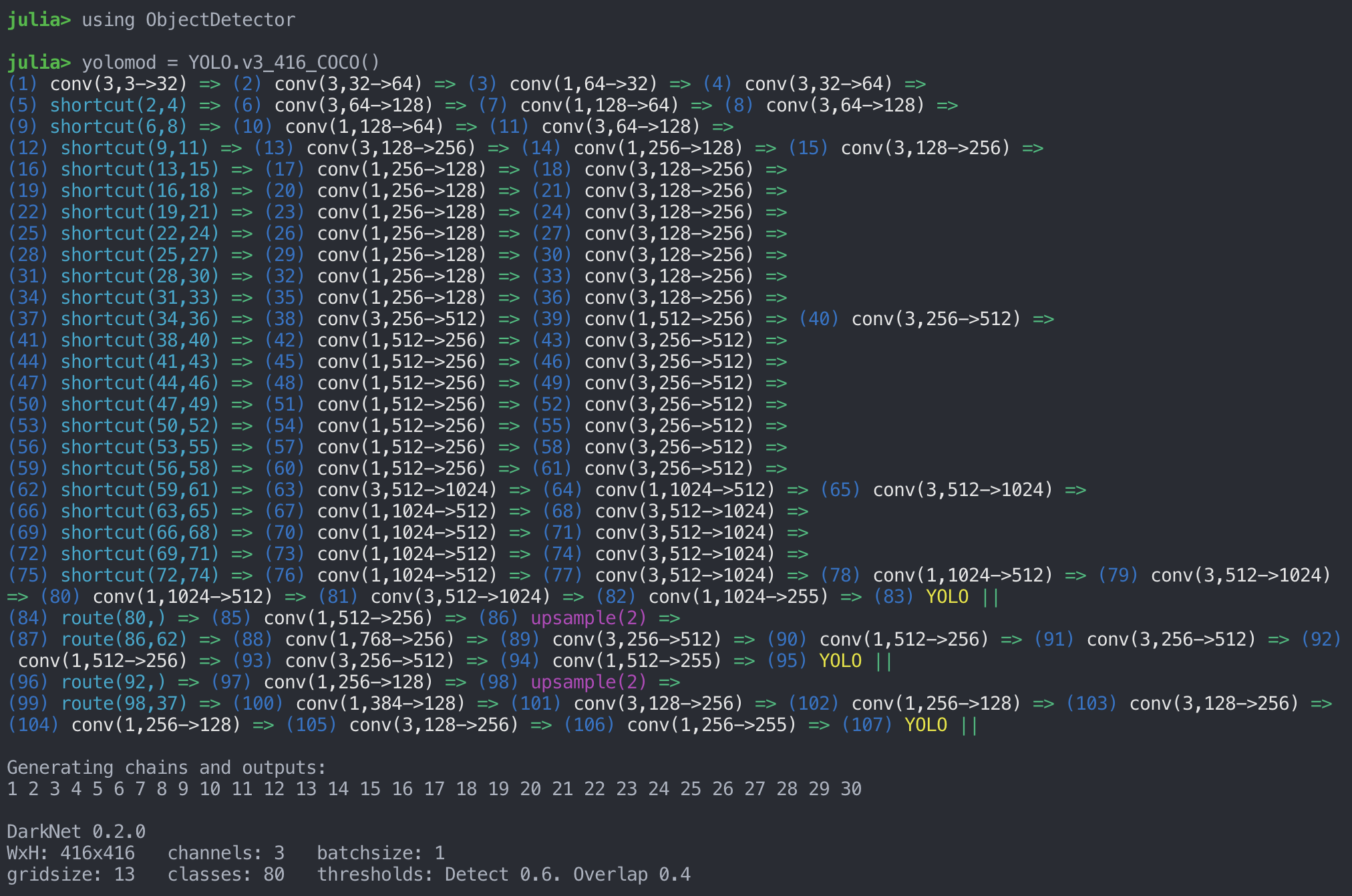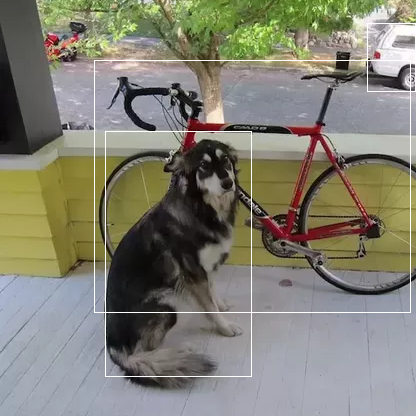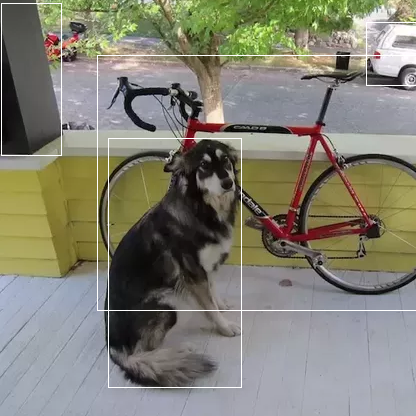Object detection via YOLO in Julia. YOLO models are loaded directly from Darknet .cfg and .weights files as Flux models. Uses CUDA, if available.
Requires julia v1.3+. From the Julia REPL, type ] to enter the Pkg REPL mode and run:
pkg> add ObjectDetector
As of ObjectDetector v0.3, if you want to use CUDA accelleration you will also need to
add CUDA and cuDNN to your project and load both packages.
using ObjectDetector, FileIO
yolomod = YOLO.v3_608_COCO(batch=1, silent=true) # Load the YOLOv3-tiny model pretrained on COCO, with a batch size of 1
batch = emptybatch(yolomod) # Create a batch object. Automatically uses the GPU if available
img = load(joinpath(dirname(dirname(pathof(ObjectDetector))),"test","images","dog-cycle-car.png"))
batch[:,:,:,1], padding = prepareImage(img, yolomod) # Send resized image to the batch
res = yolomod(batch, detectThresh=0.5, overlapThresh=0.8) # Run the model on the length-1 batchNote that while the convention in Julia is column-major, where images are loaded
such that a widescreen image matrix would have a smaller 1st dimension than 2nd.
Darknet is row-major, so the image matrix needs to have its first and second dims
permuted before being passed to batch. Otherwise features may not be detected due to
being rotated 90º. The function prepareImage() includes this conversion automatically.
Also, non-square models can be loaded, but care should be taken to ensure that each dimension is an integer multiple of the filter size of the first conv layer (typically 16 or 32).
imgBoxes = drawBoxes(img, yolomod, padding, res)
save("result.png", imgBoxes)The darknet YOLO models from https://pjreddie.com/darknet/yolo/ that are pretrained on the COCO dataset are available:
YOLO.v2_COCO() #Currently broken
YOLO.v2_tiny_COCO()
YOLO.v3_COCO()
YOLO.v3_spp_608_COCO() #Currently broken
YOLO.v3_tiny_COCO()Their width and height can be modified with:
YOLO.v3_COCO(w=416,h=416)and further configurations can be modified by editing the .cfg file structure after its read, but before its loaded:
yolomod = YOLO.v3_COCO(silent=false, cfgchanges=[(:net, 1, :width, 512), (:net, 1, :height, 384)])cfgchanges takes the form of a vector of tuples with:
(layer symbol, ith layer that matches given symbol, field symbol, value)
Note that if cfgchanges is provided, optional h and w args are ignored.
Also, convenient sized models can be loaded via:
YOLO.v2_608_COCO()
YOLO.v2_tiny_416_COCO()
YOLO.v3_320_COCO()
YOLO.v3_416_COCO()
YOLO.v3_608_COCO()
YOLO.v3_spp_608_COCO()
YOLO.v3_tiny_416_COCO()Or custom models can be loaded with:
YOLO.yolo("path/to/model.cfg", "path/to/weights.weights", 1) # `1` is the batch size.For instance the pretrained models are defined as:
function v3_COCO(;batch=1, silent=false, cfgchanges=nothing, w=416, h=416)
cfgchanges=[(:net, 1, :width, w), (:net, 1, :height, h)]
yolo(joinpath(models_dir,"yolov3-416.cfg"), joinpath(artifact"yolov3-COCO", "yolov3-COCO.weights"), batch, silent=silent, cfgchanges=cfgchanges)
endThe weights are stored as lazily-loaded julia artifacts (introduced in Julia 1.3).
Pretrained models can be easily tested with ObjectDetector.benchmark().
Note that the benchmark was run once before the examples here. Initial load time of the first model loaded is typically between 3-20 seconds. See the package-compilation section below for compilation instructions to speed up loading.
A desktop with a GTX 2060:
julia> ObjectDetector.benchmark()
┌──────────────────┬─────────┬───────────────┬──────┬──────────────┬────────────────┐
│ Model │ loaded? │ load time (s) │ ran? │ run time (s) │ run time (fps) │
├──────────────────┼─────────┼───────────────┼──────┼──────────────┼────────────────┤
│ v2_tiny_416_COCO │ true │ 0.16 │ true │ 0.0037 │ 266.7 │
│ v3_tiny_416_COCO │ true │ 0.243 │ true │ 0.0042 │ 236.4 │
│ v3_320_COCO │ true │ 1.264 │ true │ 0.0209 │ 47.8 │
│ v3_416_COCO │ true │ 1.456 │ true │ 0.031 │ 32.3 │
│ v3_608_COCO │ true │ 2.423 │ true │ 0.0686 │ 14.6 │
└──────────────────┴─────────┴───────────────┴──────┴──────────────┴────────────────┘
A 2019 Macbook Pro (CPU-only, no CUDA):
┌──────────────────┬─────────┬───────────────┬──────┬──────────────┬────────────────┐
│ Model │ loaded? │ load time (s) │ ran? │ run time (s) │ run time (fps) │
├──────────────────┼─────────┼───────────────┼──────┼──────────────┼────────────────┤
│ v2_tiny_416_COCO │ true │ 0.305 │ true │ 0.1383 │ 7.2 │
│ v3_tiny_416_COCO │ true │ 0.267 │ true │ 0.1711 │ 5.8 │
│ v3_320_COCO │ true │ 1.617 │ true │ 0.8335 │ 1.2 │
│ v3_416_COCO │ true │ 2.377 │ true │ 1.4138 │ 0.7 │
│ v3_608_COCO │ true │ 4.239 │ true │ 3.1122 │ 0.3 │
└──────────────────┴─────────┴───────────────┴──────┴──────────────┴────────────────┘
All run with detectThresh = 0.5, overlapThresh = 0.5
If initial load times are critical, the package can be compiled and loaded as a sysimage, such that initial load time reduces to ~4 seconds, and loading of the first model also takes ~4 seconds (as opposed to current performance on 1.3.0 of ~20 seconds for package load, and ~20 seconds for first model load).
See dev/compilation/compiler.jl for instructions.





